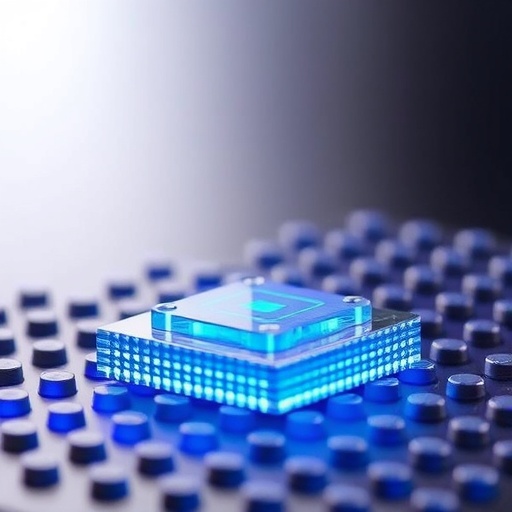In the frontier of semiconductor research, memristors have emerged as the last fundamental passive circuit element, revolutionizing the landscape of electronics since their conceptual inception by Dmitri Strukov in 2008. These devices, composed primarily of thin films containing dielectric materials rich in oxygen vacancies, possess the remarkable ability to adjust their resistance in response to both the magnitude and direction of electrical current. The complex behavior of their resistance with current flow is nonlinear, a property that lends memristors their unique capability to “remember” past electrical states. This trait positions them as indispensable components for advancing neuromorphic computing, dense data storage solutions, and power-efficient information processing systems, all while outperforming conventional silicon-based transistors in energy consumption.
Expanding beyond data storage, memristors present transformative opportunities for real-time, energy-conscious data stream processing. By integrating processing functions directly into memory elements, these devices enable ultrafast computations with lower costs and reduced power demands. Flexibly embedded within artificial intelligence architectures, memristor-based neuromorphic processors have the potential to empower neural networks to learn dynamically on compact platforms, including handheld mobile devices. Researchers worldwide continue to innovate diverse memristor configurations aiming to support advanced applications such as machine vision, acoustic and speech recognition systems, and sophisticated biointerfacing technologies.
The performance and reliability of memristors are heavily dependent on intrinsic material characteristics, contact engineering, and device miniaturization. Here, lead halide perovskites have garnered considerable attention as a promising semiconductor class owing to their versatile applications ranging from photovoltaic cells and photodiodes to light-emitting diodes and sensors. These materials exhibit excellent semiconductor behavior suitable for use in memristors, both with and without the formation of conductive filaments, which are crucial for switching resistance states. The ability of halide perovskites to endure environmental fluctuations while maintaining their electronic properties underscores their potential for durable, efficient memristive devices.
Notwithstanding significant progress, understanding and achieving stable electrical characteristics in perovskite memristors under prolonged voltage stress remains a formidable challenge. The inherent formation of conductive filaments, coupled with metal-ion penetration from electrodes into the perovskite layer under ambient humidity and temperature conditions, threatens device longevity and operational stability. Key hurdles involve enhancing cycling endurance to optimize switching performance, minimizing power consumption, and achieving device miniaturization without compromising function. Thorough investigation into defect dynamics and ion migration within the perovskite lattice is necessary to unravel the complex switching mechanisms underpinning device behavior.
In a groundbreaking study led by Prof. Sergey Makarov’s research group at ITMO University and Harbin Engineering University, scientists have engineered one of the smallest memristors based on a cesium lead bromide (CsPbBr3) perovskite nanocube, recognized for its chemical stability compared to other lead-halide variants. These monocrystalline nanocubes were carefully synthesized directly onto indium tin oxide (ITO) substrates, sandwiched between chemically inert contacts—ITO at the bottom and boron-doped diamond (BDD) at the top. This unique configuration allows precise control and coupling of the perovskite crystal with the electrode, enabling direct measurement of current-voltage (J-V) characteristics over thousands of cycles, confirming remarkable stability.
Critical insights emerged from exploring how the nanocube’s thickness influenced resistive switching and power usage. The team achieved an unprecedented low power consumption for switching state, registering between 70 and 80 nanowatts for crystals sized between 130 to 150 nanometers. This ultra-low power threshold is among the smallest values reported for memristors, enhancing their viability for highly energy-efficient electronics. Furthermore, the distinct current ratio exceeding 10^5 between the binary ON and OFF states promises clear computational readability and reliability, vital for practical memory and logic applications.
To decode the memristive behavior of their devices, researchers employed an advanced drift-diffusion model that uniquely incorporated dual mobile ionic species—both anions and cations—within the perovskite lattice, a marked departure from traditional semiconductor models focusing solely on electron and hole transport. These ions, possessing slower mobility relative to electronic carriers, dynamically modulate the internal electrical potential, thereby impacting the current flow dependent on the applied voltage history. This ionic drift introduces a temporal memory effect, locking the device’s conduction state based on previously applied voltages.
The study elucidated that memory functionality arises not only from ion redistribution but also from critical ion-contact interactions at the interfaces. These interactions notably decrease energy barrier heights, fostering enhanced electronic tunneling across the perovskite-contact interface. This synergistic interplay between the mobile ions and the chemical contacts is essential to supporting the observed non-volatile resistive switching, setting a foundation for robust device design strategies that optimize both ionic and electronic transport mechanisms.
The work’s leading authors bring diverse expertise supporting this breakthrough. Abolfazl Mahmoodpoor, currently a PhD candidate deeply engaged in numerical modeling of ion migration phenomena in perovskite semiconductors, contributed significant theoretical and simulation insights. Prokhor Alekseev, with a strong background in scanning probe microscopy and semiconductor physics, facilitated precise characterization of the nanoscale electrical properties. Meanwhile, Ksenia Gasnikova has recently embraced advanced microscopy techniques to probe the intricate nanostructures. Prof. Sergey Makarov’s extensive background in nanophotonics and solution-processed devices, combined with Prof. Aleksandra Furasova’s leadership in perovskite device fabrication and experimental analysis, orchestrated this comprehensive investigation.
Taken together, these advancements affirm the promise of halide perovskite-based nanomemristors as next-generation building blocks for ultralow-power neuromorphic computation and memory technologies. The unique chemical robustness and tunable ionic-electronic transport dynamics foster new paradigms in memory retention and device scalability. This pioneering research opens pathways for practical memristive devices that can seamlessly integrate into portable electronics, AI hardware, and biointerfaces, propelling the boundaries of sustainable and intelligent computing.
For further exploration and technical depth, the full research article is accessible via the journal “Opto-Electronic Advances,” providing an exhaustive account of experimental methods, theoretical modeling, and implications for future semiconductor device innovations.
Subject of Research: Development and characterization of ultralow-power halide perovskite nanomemristors based on CsPbBr3 monocrystalline nanocubes interfaced with chemically inert electrodes.
Article Title: Halide perovskite volatile unipolar Nanomemristor
News Publication Date: 14-Oct-2025
Web References: https://www.oejournal.org/oea/article/doi/10.29026/oea.2025.250110
Image Credits: Abolfazl Mahmoodpoor, Aleksandra Furasova
Keywords: memristor, halide perovskite, CsPbBr3, nanocube, neuromorphic computing, ionic drift, resistive switching, low power consumption, boron-doped diamond electrode, indium tin oxide, drift-diffusion modeling, energy-efficient memory




